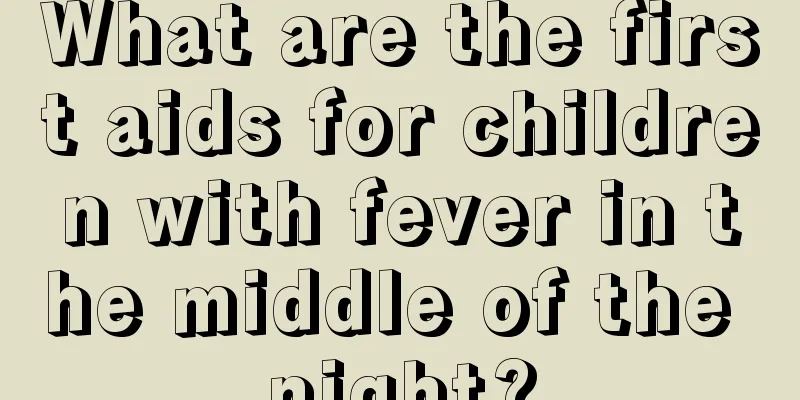Is it good for children to sleep more when they have a fever?

|
There are many reasons why children have a fever, the main one being infectious. Parents should pay more attention to this aspect. The cause of fever needs to be identified and treated. Because high body temperature can easily cause febrile convulsions in children, it is also necessary to control body temperature. At the same time, pay more attention to your child's mental state, body temperature and symptoms. When a child has a fever, his body will be very weak and he will feel powerless all over. Of course he will sleep. This will help the child recover his strength. It is recommended that you use physical cooling methods to reduce the child's fever. The physical cooling methods are as follows: 1. 35% alcohol bath Alcohol can dilate blood vessels and take away a lot of heat when it evaporates, which can help cool down infants and young children when they have a fever. Prepare 100 ml of 75% alcohol, add an equal amount of warm water, and keep the temperature at around 27-37 degrees Celsius. Do not let it be too cold, otherwise it will cause muscle contraction, causing the temperature to rise again. When doing alcohol bath, use a small towel to start wiping the baby's neck, then wipe from top to bottom in a patting manner. The armpits, groin, and areas with large arteries and blood vessels on the surface of the body should be wiped until the skin turns slightly red, which will help reduce the temperature. Be careful not to rub the baby's chest, abdomen, and soles of the feet to avoid causing adverse reactions. 2. Take a warm bath Taking a bath can help dissipate heat. If your baby is in good spirits when he has a fever, you can give him more baths and adjust the water temperature between 27 and 37 degrees Celsius. Be careful not to give your baby a hot bath, otherwise it will easily cause vasodilation throughout the body, increase oxygen consumption, easily lead to ischemia and hypoxia, and aggravate the condition. 3. Soak your feet in hot water Soaking your feet can promote blood circulation and relieve discomfort. Another benefit of soaking your baby's feet when he has a fever is that it can help reduce the temperature. You can use a large basin or a small bucket for foot soaking. Pour 2/3 of the basin with water. The water temperature should be slightly higher than usual, around 40 degrees Celsius, and it should be based on what the baby can adapt to. When soaking the baby's feet, the mother can rub the baby's two little feet, which can not only dilate the blood vessels but also relieve the discomfort caused by fever. 4. Use ice packs You can go to the store to buy chemical ice packs, put them in the refrigerator when using, take them out after they turn from gel to solid, wrap them in a towel and apply them to the top of the baby's head, forehead, neck, armpits, groin, etc., and they can be used repeatedly. You can also make your own ice packs at home: fill a disposable medical silicone glove with water, tie a knot, and place it in the freezer. Freeze it into a solid state before using. If you feel the ice is too cold, you can take out the ice bag when it is half ice and half water, wrap it in a towel and apply cold compress to your baby. 5. Ice pillow When your baby has a high fever, you can make an ice pillow for him to use as a pillow, which is both comfortable and effective. Go to the hospital and buy an ice pack (not a hot water bottle). Pour the ice into a basin, break it into small pieces, rinse off the edges with water, put them into an ice bag, add 50 to 100 ml of water (do not fill it up, 2/3 full will be enough), expel the air, clamp the bag, wrap it with cloth or towel and place it under the baby's head and neck as a pillow. When the ice cubes melt, you can replace them and the baby's body temperature will drop soon. A child's fever is a manifestation of weak resistance. In order to enhance the child's immunity, mothers are advised to start with diet. It is necessary to cook light food and eat small meals frequently. Give the child more water and ensure that the child gets enough sleep. This will help the body recover and enhance immunity. |
<<: What should I do if my child has a cough and phlegm after catching a cold?
>>: What are the causes of colds and fevers in nine-month-old babies?
Recommend
Why does my baby vomit after eating egg yolk?
Everyone knows that eggs contain a lot of nutrien...
Good aerobic exercise for kids?
There are many ways to do aerobic exercise. Diffe...
Why does my child frequently clear his throat?
A friend’s child is seven years old. For some unk...
What are the nutritional breakfast recipes for primary school students?
Now the living standard is gradually improving, s...
What are the benefits of cod liver oil supplement for babies
Babies are the future of every family. People now...
Children's growth and development indicators
Ten months of pregnancy and one day of delivery e...
Rehabilitation training methods for children with cerebral palsy
Cerebral palsy is very common in children, and th...
What is the best treatment for eczema in children?
I think everyone knows about eczema. Whether it i...
How many times is it normal for a three-month-old baby to poop?
The number of times a three-month-old baby defeca...
What to do if your child doesn't sleep at night
Parents must be very worried when their children ...
Will babies be allergic to taro?
Taro is a common food in people's daily life....
What to do if your two-year-old baby cries while sleeping at night
My child is just two years old. He didn't cry...
What should children pay attention to after tooth extraction?
Tooth extraction is a common method of treating d...
At what age do children start to change their teeth?
When we were young, we all experienced the proces...
Why do three-month-old babies suck their fingers?
The phenomenon that babies always like to suck th...









